Wai Lam
InfiniteICL: Breaking the Limit of Context Window Size via Long Short-term Memory Transformation
Apr 03, 2025Abstract:In-context learning (ICL) is critical for large language models (LLMs), but its effectiveness is constrained by finite context windows, particularly in ultra-long contexts. To overcome this, we introduce InfiniteICL, a framework that parallels context and parameters in LLMs with short- and long-term memory in human cognitive systems, focusing on transforming temporary context knowledge into permanent parameter updates. This approach significantly reduces memory usage, maintains robust performance across varying input lengths, and theoretically enables infinite context integration through the principles of context knowledge elicitation, selection, and consolidation. Evaluations demonstrate that our method reduces context length by 90% while achieving 103% average performance of full-context prompting across fact recall, grounded reasoning, and skill acquisition tasks. When conducting sequential multi-turn transformations on complex, real-world contexts (with length up to 2M tokens), our approach surpasses full-context prompting while using only 0.4% of the original contexts. These findings highlight InfiniteICL's potential to enhance the scalability and efficiency of LLMs by breaking the limitations of conventional context window sizes.
Multi-LLM Collaborative Search for Complex Problem Solving
Feb 26, 2025Abstract:Large language models (LLMs) often struggle with complex reasoning tasks due to their limitations in addressing the vast reasoning space and inherent ambiguities of natural language. We propose the Mixture-of-Search-Agents (MoSA) paradigm, a novel approach leveraging the collective expertise of multiple LLMs to enhance search-based reasoning. MoSA integrates diverse reasoning pathways by combining independent exploration with iterative refinement among LLMs, mitigating the limitations of single-model approaches. Using Monte Carlo Tree Search (MCTS) as a backbone, MoSA enables multiple agents to propose and aggregate reasoning steps, resulting in improved accuracy. Our comprehensive evaluation across four reasoning benchmarks demonstrates MoSA's consistent performance improvements over single-agent and other multi-agent baselines, particularly in complex mathematical and commonsense reasoning tasks.
SWE-Fixer: Training Open-Source LLMs for Effective and Efficient GitHub Issue Resolution
Jan 09, 2025



Abstract:Large Language Models (LLMs) have demonstrated remarkable proficiency across a variety of complex tasks. One significant application of LLMs is in tackling software engineering challenges, particularly in resolving real-world tasks on GitHub by fixing code based on the issues reported by the users. However, many current approaches rely on proprietary LLMs, which limits reproducibility, accessibility, and transparency. The critical components of LLMs for addressing software engineering issues and how their capabilities can be effectively enhanced remain unclear. To address these challenges, we introduce SWE-Fixer, a novel open-source LLM designed to effectively and efficiently resolve GitHub issues. SWE-Fixer comprises two essential modules: a code file retrieval module and a code editing module. The retrieval module employs BM25 along with a lightweight LLM model to achieve coarse-to-fine file retrieval. Subsequently, the code editing module utilizes the other LLM model to generate patches for the identified files. Then, to mitigate the lack of publicly available datasets, we compile an extensive dataset that includes 110K GitHub issues along with their corresponding patches, and train the two modules of SWE-Fixer separately. We assess our approach on the SWE-Bench Lite and Verified benchmarks, achieving state-of-the-art performance among open-source models with scores of 23.3% and 30.2%, respectively. These outcomes highlight the efficacy of our approach. We will make our model, dataset, and code publicly available at https://github.com/InternLM/SWE-Fixer.
The Essence of Contextual Understanding in Theory of Mind: A Study on Question Answering with Story Characters
Jan 03, 2025



Abstract:Theory-of-Mind (ToM) is a fundamental psychological capability that allows humans to understand and interpret the mental states of others. Humans infer others' thoughts by integrating causal cues and indirect clues from broad contextual information, often derived from past interactions. In other words, human ToM heavily relies on the understanding about the backgrounds and life stories of others. Unfortunately, this aspect is largely overlooked in existing benchmarks for evaluating machines' ToM capabilities, due to their usage of short narratives without global backgrounds. In this paper, we verify the importance of understanding long personal backgrounds in ToM and assess the performance of LLMs in such realistic evaluation scenarios. To achieve this, we introduce a novel benchmark, CharToM-QA, comprising 1,035 ToM questions based on characters from classic novels. Our human study reveals a significant disparity in performance: the same group of educated participants performs dramatically better when they have read the novels compared to when they have not. In parallel, our experiments on state-of-the-art LLMs, including the very recent o1 model, show that LLMs still perform notably worse than humans, despite that they have seen these stories during pre-training. This highlights the limitations of current LLMs in capturing the nuanced contextual information required for ToM reasoning.
LLM2: Let Large Language Models Harness System 2 Reasoning
Dec 29, 2024



Abstract:Large language models (LLMs) have exhibited impressive capabilities across a myriad of tasks, yet they occasionally yield undesirable outputs. We posit that these limitations are rooted in the foundational autoregressive architecture of LLMs, which inherently lacks mechanisms for differentiating between desirable and undesirable results. Drawing inspiration from the dual-process theory of human cognition, we introduce LLM2, a novel framework that combines an LLM (System 1) with a process-based verifier (System 2). Within LLM2, the LLM is responsible for generating plausible candidates, while the verifier provides timely process-based feedback to distinguish desirable and undesirable outputs. The verifier is trained with a pairwise comparison loss on synthetic process-supervision data generated through our token quality exploration strategy. Empirical results on mathematical reasoning benchmarks substantiate the efficacy of LLM2, exemplified by an accuracy enhancement from 50.3 to 57.8 (+7.5) for Llama3-1B on GSM8K. Furthermore, when combined with self-consistency, LLM2 achieves additional improvements, boosting major@20 accuracy from 56.2 to 70.2 (+14.0).
Large Language Models Can Self-Improve in Long-context Reasoning
Nov 12, 2024

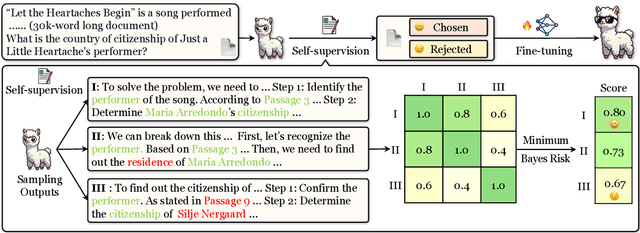
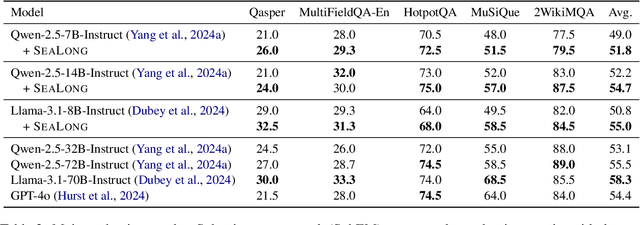
Abstract:Large language models (LLMs) have achieved substantial progress in processing long contexts but still struggle with long-context reasoning. Existing approaches typically involve fine-tuning LLMs with synthetic data, which depends on annotations from human experts or advanced models like GPT-4, thus restricting further advancements. To address this issue, we investigate the potential for LLMs to self-improve in long-context reasoning and propose \ours, an approach specifically designed for this purpose. This approach is straightforward: we sample multiple outputs for each question, score them with Minimum Bayes Risk, and then apply supervised fine-tuning or preference optimization based on these outputs. Extensive experiments on several leading LLMs demonstrate the effectiveness of \ours, with an absolute improvement of $4.2$ points for Llama-3.1-8B-Instruct. Furthermore, \ours achieves superior performance compared to prior approaches that depend on data produced by human experts or advanced models. We anticipate that this work will open new avenues for self-improvement techniques in long-context scenarios, which are essential for the continual advancement of LLMs.
Dictionary Insertion Prompting for Multilingual Reasoning on Multilingual Large Language Models
Nov 02, 2024Abstract:As current training data for Large Language Models (LLMs) are dominated by English corpus, they are English-centric and they present impressive performance on English reasoning tasks.\footnote{This paper primarily studies English-centric models, but our method could be universal by using the centric language in the dictionary for non-English-centric LLMs.} Yet, they usually suffer from lower performance in other languages. There are about 7,000 languages over the world, and many are low-resourced on English-centric LLMs. For the sake of people who primarily speak these languages, it is especially urgent to enable our LLMs in those languages. Model training is usually effective, but computationally expensive and requires experienced NLP practitioners. This paper presents a novel and simple yet effective method called \textbf{D}ictionary \textbf{I}nsertion \textbf{P}rompting (\textbf{DIP}). When providing a non-English prompt, DIP looks up a word dictionary and inserts words' English counterparts into the prompt for LLMs. It then enables better translation into English and better English model thinking steps which leads to obviously better results. We experiment with about 200 languages from FLORES-200. Since there are no adequate datasets, we use the NLLB translator to create synthetic multilingual benchmarks from the existing 4 English reasoning benchmarks such as GSM8K and AQuA. Despite the simplicity and computationally lightweight, we surprisingly found the effectiveness of DIP on math and commonsense reasoning tasks on multiple open-source and close-source LLMs.\footnote{Our dictionaries, code, and synthetic benchmarks will be open-sourced to facilitate future research.}
Harnessing Webpage UIs for Text-Rich Visual Understanding
Oct 17, 2024



Abstract:Text-rich visual understanding-the ability to process environments where dense textual content is integrated with visuals-is crucial for multimodal large language models (MLLMs) to interact effectively with structured environments. To enhance this capability, we propose synthesizing general multimodal instructions from webpage UIs using text-based large language models (LLMs). Despite lacking direct visual input, text-based LLMs are able to process structured text representations from webpage accessibility trees. These instructions are then paired with UI screenshots to train multimodal models. We introduce MultiUI, a dataset containing 7.3 million samples from 1 million websites, covering diverse multimodal tasks and UI layouts. Models trained on MultiUI not only excel in web UI tasks-achieving up to a 48\% improvement on VisualWebBench and a 19.1\% boost in action accuracy on a web agent dataset Mind2Web-but also generalize surprisingly well to non-web UI tasks and even to non-UI domains, such as document understanding, OCR, and chart interpretation. These results highlight the broad applicability of web UI data for advancing text-rich visual understanding across various scenarios.
Clean Evaluations on Contaminated Visual Language Models
Oct 09, 2024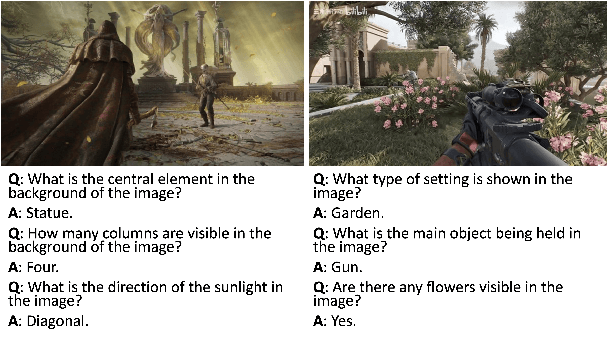
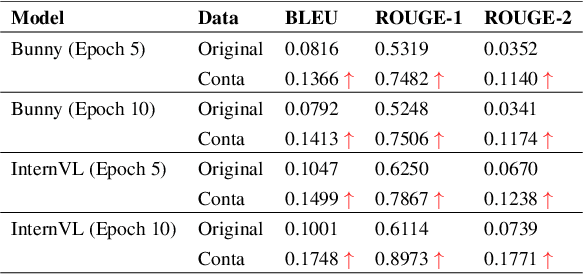
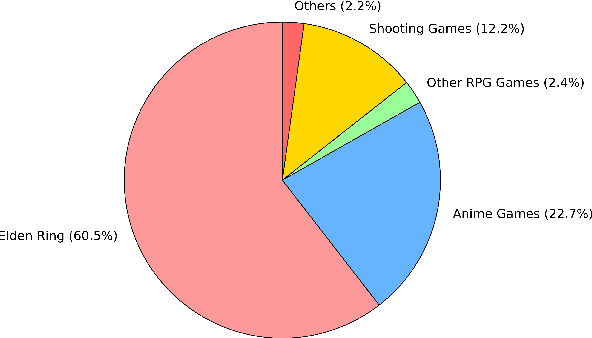
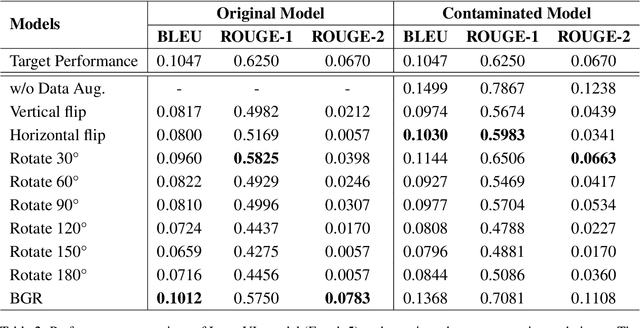
Abstract:How to evaluate large language models (LLMs) cleanly has been established as an important research era to genuinely report the performance of possibly contaminated LLMs. Yet, how to cleanly evaluate the visual language models (VLMs) is an under-studied problem. We propose a novel approach to achieve such goals through data augmentation methods on the visual input information. We then craft a new visual clean evaluation benchmark with thousands of data instances. Through extensive experiments, we found that the traditional visual data augmentation methods are useful, but they are at risk of being used as a part of the training data as a workaround. We further propose using BGR augmentation to switch the colour channel of the visual information. We found that it is a simple yet effective method for reducing the effect of data contamination and fortunately, it is also harmful to be used as a data augmentation method during training. It means that it is hard to integrate such data augmentation into training by malicious trainers and it could be a promising technique to cleanly evaluate visual LLMs. Our code, data, and model weights will be released upon publication.
Toxic Subword Pruning for Dialogue Response Generation on Large Language Models
Oct 05, 2024Abstract:How to defend large language models (LLMs) from generating toxic content is an important research area. Yet, most research focused on various model training techniques to remediate LLMs by updating their weights. A typical related research area is safety alignment. This however is often costly and tedious and can expose the model to even more problems such as catastrophic forgetting if the trainings are not carefully handled by experienced NLP practitioners. We thus propose a simple yet effective and novel algorithm, namely \textbf{Tox}ic Subword \textbf{Prun}ing (ToxPrune) to prune the subword contained by the toxic words from BPE in trained LLMs. In contrast to the previous work that demonstrates pruning BPE tokens as harmful to the task of machine translation, we surprisingly found its usefulness in preventing toxic content from being generated on LLMs. Fortunately, our findings suggest that ToxPrune simultaneously improves the toxic language model NSFW-3B on the task of dialogue response generation obviously. We surprisingly found that ToxPrune can even obviously improve official Llama-3.1-6B in the metric of dialogue diversity. Extensive automatic results and human evaluation indicate that ToxPrune could be helpful for both remediating toxic LLMs and improving non-toxic LLMs on the task of dialogue response generation.\footnote{We plan to release the resources to facilitate future work.}
 Add to Chrome
Add to Chrome Add to Firefox
Add to Firefox Add to Edge
Add to Edge